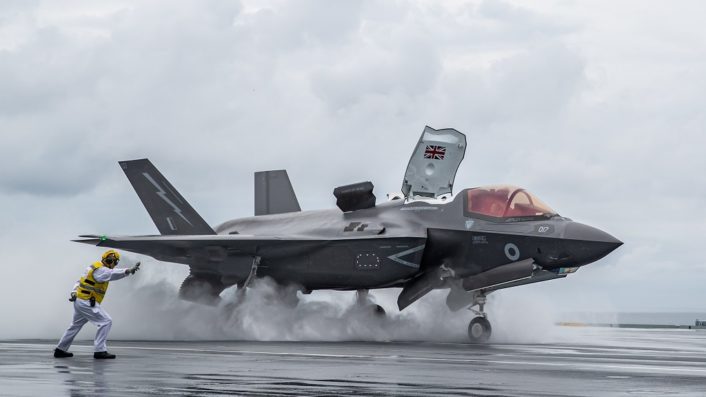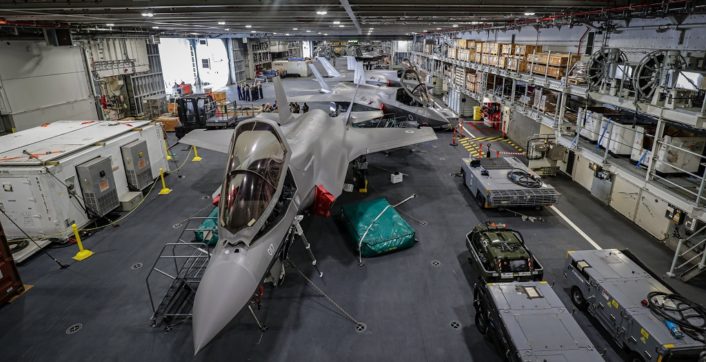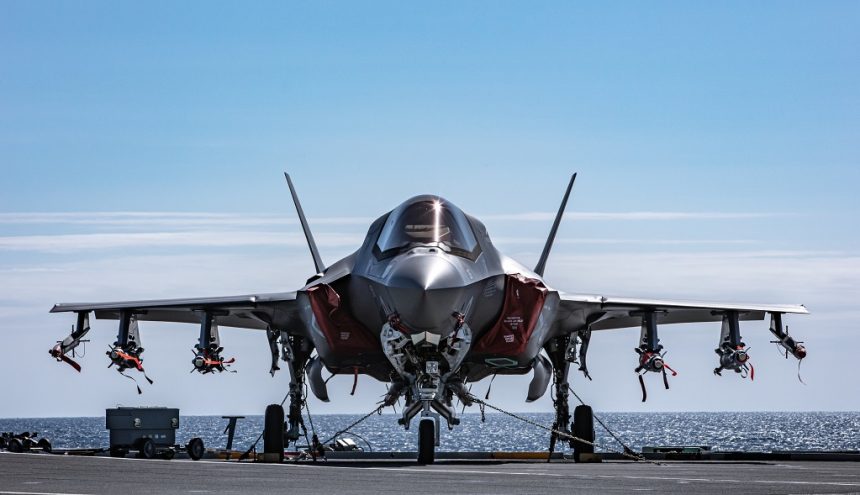The jet was fully loaded with Paveway IVs, ASRAAMs and AMRAAMs to test the ship’s Highly Automated Weapon Handling System.
The Royal Navy released on Twitter on October 23, 2019 an image of the F-35 in “Beast mode”, loaded during the tests of the Highly Automated Weapon Handling System with six (two of which internally) Paveway IV dual mode GPS/INS and laser guided bombs, two AIM-132 ASRAAMs (Advanced Short-Range Air-to-Air Missile) on the wingtips and two AIM-120 AMRAAMs (Advanced Medium-Range Air-to-Air Missile) in the weapons bays.
UK Lightning in ‘Beast’ mode onboard the future Fleet Flagship – a defining moment on the road to operational Carrier Strike capability. Up to 22,000 lbs of firepower; inert Paveway laser-guided bombs and ASRAAM air-to-air missiles. We wouldn’t mess with it either #WESTLANT19 pic.twitter.com/SPXw4pvLr2
— HMS Queen Elizabeth (@HMSQNLZ) Oct. 23 2019
The Paveway IV, latest iteration of the widely spread GBU-12 Paveway II developed for the UK with added GPS guidance, and the ASRAAM, British replacement for the AIM-9 Sidewinder, were specially integrated on the F-35 for the Royal Air Force and Royal Navy, since they don’t operate the GBU-12/EGBU-12 and the AIM-9X fielded by the USMC on their F-35Bs. The Meteor BVRAAM is also expected to be integrated on the aircraft, as the Royal Air Force recently declared it operational and will eventually replace the AMRAAM in the next years.

UK’s F-35B Lightning are currently deployed aboard the HMS Queen Elizabeth aircraft carrier for Operational Testing, while the ship is undergoing the Westlant19 Carrier Strike Group cruise off the East Coast of the United States.
As the Author wrote in a previous article, this deployment is meant to test personnel and aircraft to ensure they are compatible with the carrier. One of the key features of the ship that are being tested is the Highly Automated Weapon Handling System, a system derived from commercial automated warehousing processes that moves palletized munitions from the deep magazine and weapon preparations areas to the hangars and flight deck by using automated tracks and lifts.
One of the big advantages of the HAWHS is the reduction of manpower needed to handle munitions, thus reducing the risks for the crew during one of the most hazardous activities aboard the ship; the crew is now required to handle the weapons only during initial storage and the preparation for use on the aircraft.

During the following days, the F-35s will fly from the deck of the HMS Queen Elizabeth with various weapon’s loading configurations, including the “Beast mode”, to continue the operational testing. Here’s what our editor David Cenciotti wrote about this configuration in a previous article:
“Beast Mode” is not an official or technical term. At least not within the U.S. Air Force. However is a pretty common way an F-35 configuration involving both internal and external loads is dubbed. Actually, others call any configuration involving external loads “Bomb Truck” or “Third Day of War” configuration.
In fact, as opposed to a “First Day of War” loadout, in which the F-35 would carry weapons internally to maintain low radar cross-section and observability, the “Third Day of War” configuration is expected to be used from the third day of an air campaign when, theoretically, enemy air defense assets (including sensors, air defense missile and gun systems and enemy aircraft) have been degraded by airstrikes (conducted also by F-35s in “Stealth Mode”) and the battlespace has become more permissive: in such a scenario the F-35 no longer relies on Low-Observability for survivability so it can shift to carrying large external loads. These conditions are not always met. For instance, LO was not needed when the F-35A was called to carry out the first air strike in the Middle East, nor when the U.S. Marine Corps F-35B carried out the first air strike in Afghanistan.
On the same day, the ship saw also the arrival of the other two UK F-35s scheduled to deploy for Westlant19. The aircraft currently aboard are now ZM148 (BK-14) modex 014, ZM149 (BK-15) modex 015, ZM151 (BK-17) modex 017 from the mixed 207 Squadron/617 Squadron fleet based at RAF Marham and ZM135 (BK-01) modex 001, ZM136 (BK-02) modex 002 and ZM138 (BK-04) modex 004 from the 17 Test and Evaluation Squadron (TES) based at Edwards Air Force Base.
Two more UK Lightnings have landed onboard, as Operational Tests by @17SqnRAF and @OC617Sqn continue. The deck is getting busier and louder with six 🇬🇧⚡️ now embarked, #WESTLANT19 is just a taste of what is to come. @RoyalNavy @RoyalAirForce #bigdecksfastjets #FlyNavy #QNLZatSea pic.twitter.com/aiwjzNKkLS
— HMS Queen Elizabeth (@HMSQNLZ) Oct. 23 2019
USMC F-35Bs are expected to deploy on HMS Queen Elizabeth in the following days to conduct trials before a joint operational deployment with the RAF/RN F-35s in 2021.
It’s not all about #bigdecksfastjets – rotary wing ops continue on #WESTLANT19 as we welcome onboard @USMC CH-53 Super Stallion. These heavy lift helicopters will allow us to embark USMC personnel ahead of their F-35Bs joining us for trials very soon & deploying with us in 2021. pic.twitter.com/qmPXmMmWRX
— HMS Queen Elizabeth (@HMSQNLZ) 18 ottobre 2019









